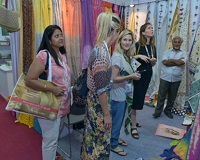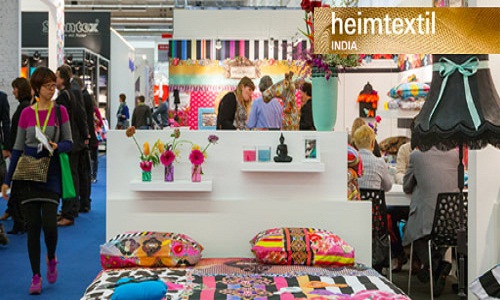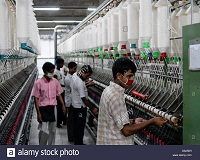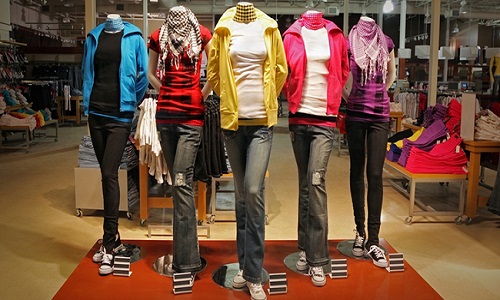FW
"Heimtextil India and Ambiente India, touted as India’s premium fairs for home textiles, homeware and interior décor, have launched Bespoke Living, an exclusive product showcase space dedicated to companies dealing with signature collections at Pragati Maidan, New Delhi from June 27–29, 2018. With four successful editions, Heimtextil India and Ambiente India, also slated on the same dates, have become the country’s leading business trade fairs to showcase the finest quality of dining, living, giving and home textiles. The launch of Bespoke Living is aimed at highlighting unique brands dealing with crafted designs that will range from plush statement pieces to extensive signature collections for home and retail furnishing."

Heimtextil India and Ambiente India, touted as India’s premium fairs for home textiles, homeware and interior décor, have launched Bespoke Living, an exclusive product showcase space dedicated to companies dealing with signature collections at Pragati Maidan, New Delhi from June 27–29, 2018. With four successful editions, Heimtextil India and Ambiente India, also slated on the same dates, have become the country’s leading business trade fairs to showcase the finest quality of dining, living, giving and home textiles. The launch of Bespoke Living is aimed at highlighting unique brands dealing with crafted designs that will range from plush statement pieces to extensive signature collections for home and retail furnishing.

The term luxury décor is not restricted to brand names anymore. With trends like fully furnished luxury houses, theme dominated homes and tastefully designed retail showrooms rapidly picking up in the country, consumers are open to different styles and unique designs. Be it the very popular Scandinavian themed houses to colourful cultural artefacts creating a soothing aura, Indians now want their homes and businesses to reflect their personal style with statement interiors.
Halls dedicated to Bespoke Living will feature selected designer brands from India and around the world showcasing their premium collections. This product showcase arena will be beneficial for interior designers, architects, hotel buyers, buyers of luxury goods and luxury homes developers. Business visitors can gain knowledge about the upcoming trends, source timeless pieces, build new connections with people sharing the same interest and experience the quality of the products in person. Exposure to best in class products and latest trends presented here will help them create a better home design experience for their clients.
Displaying regal designs
Excelling in statement leather pieces the brand Three Sixty will showcase their latest leather collection that comprises of rugged travel accessories and signature furniture pieces. Inspired by the world’s deserts and explorers who traversed them, the brand designs fully customisable handmade products, which are available in beautiful shades of tan. “Our latest collection at Bespoke Living will showcase our ever-evolving tastes and designs. We believe luxury need not be synonymous with breaking open the bank. Traditional Indian craftsmen can craft the most beautiful signature pieces and provide quality beyond compare,” shared Vikash Gupta, CEO, Three Sixty. International exhibitors present at the show will showcase exquisite artefacts like decorative ceramics with glaze, handmade clay wreaths with metal leaves, ceramic vases and other decorative items to make every home unique.
Apart from this specially curated design platform, Heimtextil India and Ambiente India 2018 will host the Interior Lifestyle Awards that will bring creative masters from the interior decor and home textile sectors together by recognising their art and giving them an international platform to showcase their designs. The trade fair will also organise the Hospitality Day, a hospitality and retail procurement programme that will bring top class purchase managers from the industry to build new contacts and source quality products. Together, Heimtextil India and Ambiente India will host over 100 companies from countries like India, Indonesia, Switzerland and Thailand showcasing trendsetting designs in the interior décor and home textile industry.
"Grabbing the third spot, Bangladesh is reigning its share in global exports of textile and apparel products. The country’s exports registered a growth of 9 per cent over the last five years to reach $34.4 billion in 2016, while imports have increased at a CAGR of 7 per cent in the same period to reach $10.3 billion in 2016. Bangladesh’s textile and apparel trade balance recorded a surplus of around $24.1 billion in 2016. When we talk about imports, cotton is the largest imported category by Bangladesh, representing 55 per cent of total textile and apparel imports (2016). This is followed by man-made textiles, others and apparel with a share of 35.0 per cent, 6.8 per cent and 3.2 per cent respectively. Top 10 suppliers accounted for around 94 per cent of textile and apparel imports by Bangladesh. China is the largest supplier accounting for 58 per cent share, followed by India and Pakistan with a share of 19 per cent and 6 per cent respectively."

Grabbing the third spot, Bangladesh is reigning its share in global exports of textile and apparel products. The country’s exports registered a growth of 9 per cent over the last five years to reach $34.4 billion in 2016, while imports have increased at a CAGR of 7 per cent in the same period to reach $10.3 billion in 2016. Bangladesh’s textile and apparel trade balance recorded a surplus of around $24.1 billion in 2016. When we talk about imports, cotton is the largest imported category by Bangladesh, representing 55 per cent of total textile and apparel imports (2016). This is followed by man-made textiles, others and apparel with a share of 35.0 per cent, 6.8 per cent and 3.2 per cent respectively. Top 10 suppliers accounted for around 94 per cent of textile and apparel imports by Bangladesh. China is the largest supplier accounting for 58 per cent share, followed by India and Pakistan with a share of 19 per cent and 6 per cent respectively.
India business relations

India is the second largest supplier of textile and apparel products to Bangladesh, at around $2 billion in 2016. It has registered a CAGR of 4 per cent over the last five years. Cotton textiles is the largest category with a share of 77 per cent in India’s T&A exports to Bangladesh. This is followed by man-made textiles and apparel having share of 17 per cent and 4 per cent respectively.
Currently, Bangladesh imports its required consumption of yarn and fabric from China, India and other nations to fill the demand-supply gap. It has served as a key export market for Indian cotton and man-made textiles since long. However, many new investments are the offing in the spinning and weaving sectors of Bangladesh in the coming years with many big firms taking a keen interest to set up spinning and weaving units there.
Going by its strong emphasis on the sector, the country is soon going to emerge as a self-sufficient textile and apparel hub by focussing more on backward integration in the next 10 years. This is expected to lower the export opportunities for China and India. While Bangladesh is a key export market for Indian textiles, it will be important for Indian firms whose major export market is Bangladesh to look for newer markets for their exports in the coming years.
From January to February 2018, China, Mexico and Bangladesh were the top three denim exporters to the US. In the Men and Boys (MB) category, US jeans imports surged 6.60 per cent on a year-on-year basis. While in the Women and Girls (WG) category US jeans imports increased 9.23 per cent.
China remains the key exporter in the WG category as well followed by Bangladesh. However, Mexico overtook both countries this time in the MB category to grab the top spot in the tally.
Mexico exported denim trousers valued worth $97.24 million (down 6.22 per cent), beating China’s export value in the same category which stood at just $34.20 million. However, Mexico’s share in WG jeans exports was way less than China’s share. As for Bangladesh, its export value of MB denim trousers to the US was up 20.13 per cent. On the other hand, in the WG category, the South Asian giant’s export value grew 4.81 per cent.
However, the share of jeans in total cotton trouser imports by the US is falling. The US import market for denim apparel is extremely tough and competitive. This market is characterized by extremely competitive pricing structures.
NILIT, the worldwide leader in Nylon 6.6 for active wear, intimate apparel, hosiery and other apparel will showcase at the upcoming Performance Days trade show to be held from in Munich on April 18-19. The show provides a unique forum where fashion professionals and textile suppliers can discover and share latest product, trend and market innovation ideas for the apparel market.
Nilit’s Vice President of Global Marketing and R&D Pierluigi Berardi will also present a workshop on April 19. Sensil will showcase at the Performance Days Fabric forum selections from premium European fabric producers, and these fabrics will be designed with Sensil Breeze, to provide athletes with a refreshing cooling effect when body heat and temperatures rise. Cooling fabric technology is just one topic that Pierluigi Berardi will discuss in the Performance Fabrics for People and Planet workshop.
Sensil is the premium Nylon 6.6 from Nilit for apparel that is used in intimate apparel, legwear, activewear, athletic wear, outdoor apparel, denim, and other products. Nilit is a producer and marketer of high quality Nylon 6.6 fibres for apparel and other products. The company was founded over 40 years ago in Israel and has grown to be one of the largest Nylon 6.6 producer, with manufacturing and marketing operations in key regions including Europe, North America, Latin America, China, Asia Pacific, and Turkey.
Outdoor chain REI has unveiled a set of guidelines covering each of the more than 1,000 brands sold at the co-op. The standards outline the company’s expectations for its brand partners, focusing on how they manage environmental, social and animal welfare concerns, in coordination with REI’s ongoing sustainability efforts.
REI is known for its quality outdoor gear and clothing.With these new manufacturing policies, REI is not only reassuring customers that goods will continue to deliver top-rate performance, the company is also informing shoppers that the goods sold at its stores are manufactured by responsible, environmentally sound businesses.
Among the guidelines are those requiring brands to have a manufacturing code of conduct for supply chains. The animal welfare restriction pertains to prohibiting brands from using animal fur and exotic leather. There are restrictions regarding the use of certain wool.
REI is also introducing a list of preferred attributes that let shoppers use keywords like organically grown cotton and recycled materials to search for products, pushing them to brands and products that are using socially responsible and sustainable manufacturing practices. Consumers increasingly expect that retailers they buy from have done their homework in understanding the social and environmental practices of the brands they carry.
For Q1, LVMH sales rose 13 per cent on an organic basis. With this, LVMH has set an upbeat tone for the luxury industry. Prosperous Chinese consumers have been stocking up on LVMH’s Louis Vuitton handbags and Givenchy makeup, powering record sales last year for the company with the highest market value in France.
With more than 4,000 stores across the world, LVMH is getting a boost from a rising Chinese middle class that is traveling more than ever. It’s also gaining from a push into e-commerce and new products to entice young consumers -- like luxury sneakers and iPhone cases styled like Louis Vuitton trunks.
LVMH highlighted its digital efforts, such as its sponsorship for a startup accelerator that aims to encourage entrepreneurs developing new technologies and services for the luxury industry. LVMH moved to ramp up its e-commerce business across its stable of brands last year with new sites for its Celine handbags and Berluti shoes, the first online store in China for its largest brand, Louis Vuitton, and a new multibrand emporium. The company saw organic growth of 10 per cent or greater in categories such as spirits, fashion goods, cosmetics and jewelry.
Denim manufacturer Isko has produced a new version of selvedge by combining pure craftsmanship with the latest denim technological advancements. Isko is producing classic rigid qualities through to comfort and high-stretch items, ready to assume the role of a go-to selvedge denim mill for leading brands worldwide.
The result is a premium quality durable fabric that gets better with every wear, an assortment of over 20 selvedge varieties that includes weights spanning from 7.5 to 20 oz. Such diversity caters for silhouettes going from men’s and women’s bottoms to tops, such as shirts and jackets.
Isko currently develops different selvedge products for different lifestyles, from the super vintage and authentic to clean, modern and contemporary. The assortment caters for different brand DNAs from the heritage to the contemporary. The offer is unique and incorporates ISKO’s patented technologies and every fabric is made in a responsible way.
Countless innovative products and an impressive line-up of technological solutions enable Isko to provide the best answers to the vast variety of demands within the denim sector, in particular those in the premium market segment. Isko has offices in 35 countries worldwide. Isko develops different selvedge products for different lifestyles, from the super vintage and authentic to clean, modern and contemporary.
Global yarn production in the third quarter of ’17 is slightly lower than it was in the third quarter of ’16. Global yarn stocks decreased by three per cent to six per cent in all regions in the third quarter, except in Europe, where stocks experienced a 10 percentage points increase.
Global yarn orders fell by 2.7 per cent around the world between the second and third quarters of ’17, a compound effect of a 14 per cent increase in Korea, European stability and decreases in Egypt and Brazil. Global fabric production decreased 0.6 per cent. This reflects an improvement in Brazil, stable conditions in the US and a reduction in Asia, Europe and Africa.
In the third quarter of ’17, global fabric stocks have shown a positive trend in all regions but in Egypt. This improvement was nevertheless not sufficient to bring fabrics stocks at their third quarter ’15 level, which was seven per cent higher. While conditions are relatively stable in Asia and the US, Europe indicates slow but constant positive changes.
Finally, global fabric orders have improved. A strong improvement in Brazil was compensated for by reductions in Europe and Africa, which brought the global index to 112.7 per cent of its previous quarter level, very close to its third quarter ’15 level.
Over the past decade, the stretchy workout pant leggings which had for years been limited to a life inside the gym, has substituted the traditional pair of jeans as casual wear for women, allowing brands like Lululemon and Nike to reach a whole new demographic of women by supplying athleisure apparel category.
With widespread every-day adoption of athleisure classic sportswear brands, have profited significantly. As the trend solidified as a lasting sartorial statement, Nikes were joined by lifestyle and fashion brands and even celebrity-fronted collections, which introduced activewear lines in an attempt to bank on the frequency of athleticwear turning up outside of the gym.
At present athleisure craze is increasing as some analysts reached its saturation point and as a result, sales are beginning to slow. It has resulted in a renewed interest in denim. Sales of many traditional sportswear giants are starting to fall when it comes to stretchy leggings and crop tops, while discounters Walmart and Target are pushing further into sportswear, and fast-fashion retailers like Forever 21 and H&M getting in the game causing prices to come down.
With jumps in revenue of Tommy Hilfiger and Calvin Klein, big mall brands, such as Madewell, Abercrombie, and the Gap, have attributed some of their late 2017 growth to increased demand for jeans, giving rise to projections that good old denim is expected to make a triumphant return to grace.
Denim has definitely made a comeback, as recently as 2018 Alta Moda couture show, an important emphasis was given on jeans. Whether its roomy Martin Margiela-inspired jeans or traditional Levi’s given the industry’s fascination with wistfulness and archival looks, a full blown reappearance of America’s traditional casual pants of choice is almost surely upon us.
The land under cotton acreage decreased by 15 per cent as more and more farmers have shifted to soyabean in the hope of better returns. Cotton Association of India (CAI) president Atul Ganatra has stated the drop in cotton planting is likely to see a increase in soybean planting after farmers received good rates during the ongoing season and a rise in import duties.
With Pink Bollworm attack Kapas sowing is expected to reduce by 10-12 per cent in Maharashtra and Telangana. He estimated the area under cotton could decrease to 108 lakh hectares in 2018-19 marketing season that starts at the beginning of October, down from 122.6 lakh hectares in the current year.
Besides in the last few months the soyabean prices have increased by about Rs 1,000 per quintal from Rs 28,000 per quintal to Rs 3,800 per quintal.
Textile Commissioner Kavita Gupta feels the shift in area under cotton might not be important. There may not be much decline in total production as area under cotton in other states may compensate for any decline in area in pink boll worm affected states. Farmers would shift to soyabean, if prices increase points out Pasha Patel, C, State Agriculture Price Commission (SAPC) and there would be no takers for cotton. The area under cotton in Maharashtra has gone up to 42 lakh hectares this season, while area under soybean dropped to 36 lakh hectares during this season.
Meanwhile, India has signed contracts to export 200,000 bales of cotton to China. India is expected to export 70 lakh bales of the fibre in 2017-18 against 58 lakh bales shipped in 2016-17 season.












